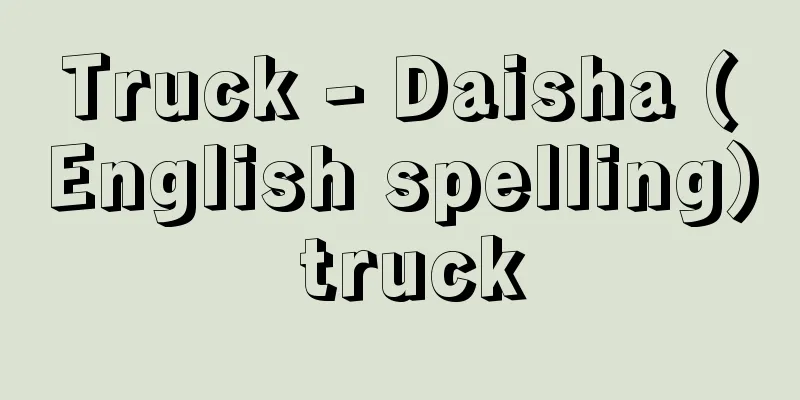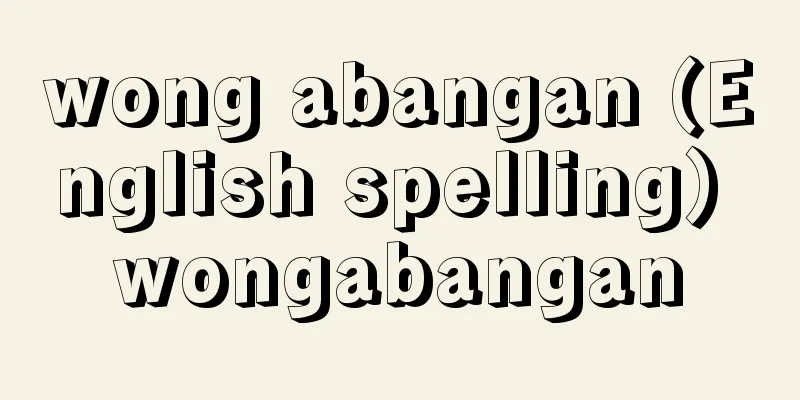Truck - Daisha (English spelling) truck

|
A structure equipped with running gear such as wheels and axles that is independent of the body of a railway vehicle. Usually, there are two bogies for one car body. The bogies can rotate freely relative to the car body to pass through curved sections. The general structure of a bogie is as follows: two or three pairs of wheels and axles as the smallest unit of the undercarriage, an axle box housing the bearings, a bogie frame forming the framework of the bogie, axle springs (primary suspension) between the axle box and the bogie frame, a bolster spring (secondary suspension) between the bogie frame and the car body, a center spring device that gives rotational freedom between the bogie frame and the car body, and a rocking bolster device that allows lateral movement between the car body and the bogie frame. The car body generally has two stages of suspension, axle springs and bolster springs, but one of these may be omitted for freight cars where ride comfort is not as important. In addition, the bogies of tilting car body trains, such as pendulum trains, are equipped with a mechanism to reduce the centrifugal force felt by passengers when passing through curves. [Nobutaka Fukuda] ClassificationBogies are classified into various categories according to their structure. A bogie with one or more driving axles attached to a drive unit is called a driving bogie, while a bogie without a driving axle is called a trailing bogie. They may also be called two-axle or three-axle bogies depending on the number of axles. The axle arrangement of a two-axle driving bogie is sometimes designated as B, while that of a three-axle driving bogie is sometimes designated as C. A four-axle locomotive with axle arrangement designated Bo-Bo is one that has two two-axle bogies, and the two driving axles are not mechanically connected. A locomotive with a Co-Co axle arrangement is one that has two three-axle driving bogies. Since around 1990, air springs that can move in the front-to-rear direction (the direction in which the bogie frame rotates) have been used as secondary suspensions, and bogies that do not have bolsters (called bolsterless bogies) have been widely used for train bogies, because this allows for a weight reduction of about 1 ton per bogie. [Nobutaka Fukuda] Axle boxThe axle box, which is the case that houses the axle bearings, is the unsprung mass together with the wheels and axles, so it is desirable for it to be lightweight. In older vehicles, the vertical load was supported by two rows of roller bearings and the lateral load was supported by ball bearings, but nowadays the mainstream type is one that supports vertical and lateral loads with two rows of tapered roller bearings. There are various types of axle box support devices that connect the axle box and the bogie frame, and these change the mass of the bogie and the supporting rigidity of the axle box, significantly affecting running performance. Previously, most axle box supports were of the pedestal type, in which the axle box slid along a friction plate inside a guide frame that was hung vertically from the bogie frame, but this had the drawbacks of leaving gaps in the fore-and-aft direction and not being able to freely choose the support stiffness. Since the mid-1980s, structures have been adopted that restrain the axle box in the fore-and-aft direction with links and leaf springs, eliminating gaps (Alstrom link type, Minden type). Other types include the chevron type, which uses the shear force of a rubber spring to generate a spring constant in the vertical direction and uses compression force to restrain the axle box in the fore-and-aft direction, and the cylindrical rubber type, which adjusts the support stiffness of the axle box in the fore-and-aft direction by compressing rubber inside a cylinder. [Nobutaka Fukuda] suspensionCoil springs and rubber springs are mainly used for axle springs. Coil springs and air springs are often used for bolster springs. Air springs have the advantage that the length of the spring does not change even if the vehicle weight changes, and the spring constant can be made small. The disadvantages are that they are more expensive than coil springs and require a supply of compressed air, but air spring bogies, which offer a comfortable ride, are now mainstream. [Nobutaka Fukuda] [Reference] | | |©Shogakukan "> Example of bogie structure and axle box support device Source: Shogakukan Encyclopedia Nipponica About Encyclopedia Nipponica Information | Legend |
|
鉄道車両の車体から独立した、車輪・車軸などの走り装置を装備した構造物。通常一つの車体に対して二つの台車をもつ構成の車両が多い。台車が車体に対して自由に回転することで曲線を通過することができる。 台車の一般的な構造は以下のとおりである。足回りの最小単位として二対または三対の輪軸、軸受を収納した軸箱、台車の骨組をなす台車枠、軸箱と台車枠の間の軸ばね(一次サスペンション)、台車枠と車体の間の枕(まくら)ばね(二次サスペンション)、台車枠と車体の間に回転の自由度を与える心皿装置、車体と台車枠との間の左右方向の動きを許容する揺れ枕装置などである。車体は軸ばねと枕ばねの2段階のサスペンションで振動を抑制するのが一般的であるが、乗り心地をそれほど重視しない貨車では一方を省略することもある。また、振子列車など車体傾斜式列車の台車には、曲線通過時に乗客が感じる遠心力を緩和するための機構が取り付けられている。 [福田信毅] 分類台車は構造によって種々の分類がされる。駆動装置が取り付けられた動軸を1本以上含む台車を動台車、動軸がない台車を従台車とよぶ。また、軸数によって、2軸台車、3軸台車とよぶこともある。2軸の動台車の軸配置をB、3軸の動台車の軸配置をCと表示することもある。4軸の機関車の軸配置でBo-Boと表示するのは2軸台車を2台もつ機関車で、二つの動軸は機械的結合がされていないことを示す。Co-Coの軸配置の機関車とは3軸の動台車を2台もつ機関車である。 なお、1990年ころから、二次サスペンションとして前後方向(台車枠が回転する方向)に変位ができる空気ばねを使い、枕梁を省略した台車(ボルスタレス台車とよぶ)が電車用台車に多く使われるようになった。これは1台車当り1トン程度の軽量化が図れるからである。 [福田信毅] 軸箱車軸の軸受を収納するケースである軸箱は、輪軸とともにばね下質量となるので、軽量であることが望ましい。古い車両では、上下荷重は2列のころ軸受(ローラーベアリング)で支え、左右方向の荷重は玉軸受(ボールベアリング)で支えていたが、現在は2列の円錐ころ軸受(円錐ローラーベアリング)で上下・左右の荷重に対応するタイプが主流である。 軸箱と台車枠を結合する軸箱支持装置には、さまざまな構造のものがあり、それによって、台車の質量、軸箱の支持剛性が変わり、走行性能に大きく影響する。 以前は、台車枠から垂直に下げられた案内枠の中を、擦り板に沿って摺動(しゅうどう)させるペデスタル式の軸箱支持装置が多かったが、前後方向に隙間ができる、支持剛性を自由に選べないという欠点があった。1980年代なかばからは、軸箱をリンクや板バネで前後方向に拘束し、隙間をつくらない構造が採用されている(アルストームリンク式、ミンデン式)。そのほか、ゴムばねの剪断(せんだん)力で上下方向のばね定数を発生させ、圧縮力で前後方向の拘束を行うシェブロン式、円筒の中のゴムの圧縮で前後方向の軸箱の支持剛性を調節する筒型ゴム式などがある。 [福田信毅] サスペンション軸ばねには主としてコイルばねとゴムばねが使われている。枕ばねには、コイルばねと空気ばねが多く使用される。空気ばねには、車体重量が変わってもばねの長さが変化せず、しかもばね定数を小さくできるという利点がある。欠点は、コイルばねより高価なこと、圧縮空気の供給が必要なことであるが、現在では乗り心地のよい空気ばね台車が主流になっている。 [福田信毅] [参照項目] | | |©Shogakukan"> 台車の構造例と軸箱支持装置 出典 小学館 日本大百科全書(ニッポニカ)日本大百科全書(ニッポニカ)について 情報 | 凡例 |
Recommend
HVC Display - HVC Display
...Therefore, the higher the C value, the more vi...
Washuzan Mountain
A mountain located in the southwest of the Kojima...
Menorca
…It is an archipelago of Spain located in the Med...
White-tailed deer
It is an animal of the Cervidae family of the ord...
Large mouse deer
It is an animal of the Mammalia class, Order Arti...
byte - yes, bye
A unit of information volume in a computer. Curren...
akçe (English spelling) akce
…These foreign coins continued to be used even af...
Caligula - Caligula (English spelling)
His real name was Gaius Julius Caesar Germanicus....
Rayon - Rayon (English spelling)
Formerly known as rayon (artificial silk thread) ...
abroholos
… 【world】 Austru A dry westerly wind that blows i...
Trichinella spiralis - Trichinella spiralis
A species of the family Trichilidae of the class D...
The Lady of Uji - The Lady of Uji
…An empress in the late Heian period, first named...
Sarmatian culture (English spelling)
A nomadic culture that spread from the Black Sea ...
Geiger, A.
...His successors found ideological agreement wit...
Seoul - Soul
The capital of South Korea (Republic of Korea) in...









